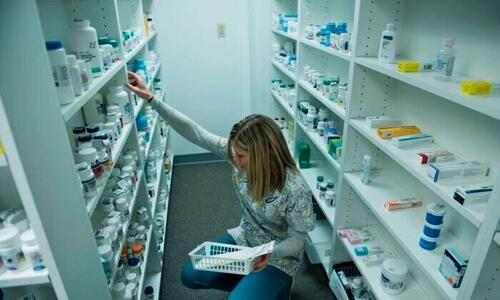US Drug Shortage Reaches Decade High: US Pharmacopeia Reports
Authored by Amie Dahnke via The Epoch Times (emphasis ours),
Drug shortages are the highest in a decade, with 2023 topping the charts, according to United States Pharmacopeia’s first annual Drug Shortage Report (USP).
“The number of drug shortages has increased over a decade, with 125 active drug shortages monitored by FDA at the end of 2023. ... This high number of shortages is a direct result of persistent market vulnerabilities,” the report authors wrote. “According to our analysis, over a quarter of drugs in shortage were new drug shortages (34 products) in 2023.”

USP is a nonprofit organization that sets quality standards for medication, dietary supplements, and food ingredients worldwide.
The report, published in early June, notes that the average drug shortage lasts more than three years and affects multiple types of drugs. Almost 25 percent of those drugs have been on shortage lists for over five years, and six drugs, including epinephrine injections, have been in short supply for a decade. Injectable generic medications have been hit hardest, comprising more than 53 percent of new drug shortages.
These drug shortages indicate vulnerability in the market and affect patient care.
“Unexpected shocks can break the system and disrupt the supply of quality medicines,” Anthony Lakavage, senior vice president for Global External Affairs at USP, said in a news release. “This worrisome trajectory leads to more frequent drug shortages, prolonged scarcity, and more people at risk of not getting the medicines they need, when they need them.”
What’s Causing the Shortage?
The report states that fundamental supply and demand are likely to blame for the drug shortages but adds that the problem in the United States is exacerbated by manufacturing complexity (e.g., sterile injectables). For instance, drug classes like antibiotics need dedicated facilities, and some active ingredients require complicated chemical synthesis.
Some of the other reasons for the shortages include:
- Race to the bottom: Most of the drugs in short supply cost less than $5 to make. Many of these cheap drugs are solid oral and sterile injectable medicines. The authors found that 66 percent of solid oral medications in shortage cost less than $3, and nearly one-third of the injectables in shortage cost less than $2. From 2022 to 2023, the number of discontinued drugs increased by 40 percent. Almost half of these are solid oral medications that cost less than $4. The report suggests tightening margins have pushed some manufacturers to pull out of the market.
- Geographic concentration: The United States produces 44 percent of injectable medication, while India produces 56 percent of solid oral medication. These concentrations of production increase supply-chain vulnerability. A well-known example of injectable drugs is semaglutide weight-loss drugs, which were in short supply during the fall and winter of 2023. These medications often require complex chemical synthesis and take more time to manufacture. They also often require more steps in the manufacturing process.
- Quality concerns: Unrelated but still problematic quality concerns have also slowed production. The report shows that in 2023, the U.S. Food and Drug Administration (FDA) inspected facilities accounting for 40 percent of drug production for having “objectionable conditions.”
“Quality comes at a price,” Vimala Raghavendran, vice president for Informatics Product Development at USP, said in the press release. “The economics of generic drugs often leave manufacturers with razor-thin margins, making it challenging to prioritize investment in modern machinery or to elevate standards of quality. Without sufficient profitability, the cycle of innovation and improvement becomes difficult to sustain.”
The Solution
U.S. Pharmacopeia, which touts itself as an independent, science-based nonprofit focused on building trust in the supply of safe medication, has joined with other national health care organizations in a call to action for the long-term, systemic solutions to the U.S. pharmacy drug shortage.
“As we navigate the complex landscape of drug shortages, it is paramount to shift the market into a stable state,” Mr. Lavakage said.
The coalition called upon policymakers to promote lower-priced drugs and a sustainable, high-quality supply chain. Its suggestions were to:
- “Coordinate supply chain resilience and reliability efforts”
- “Increase supply chain visibility”
- “Establish a vulnerable medicines list”
- “Align the market to incentivize a quality and adequate supply chain”
- “Bolster manufacturing capacity”
- Fund “research to better understand market interactions”

